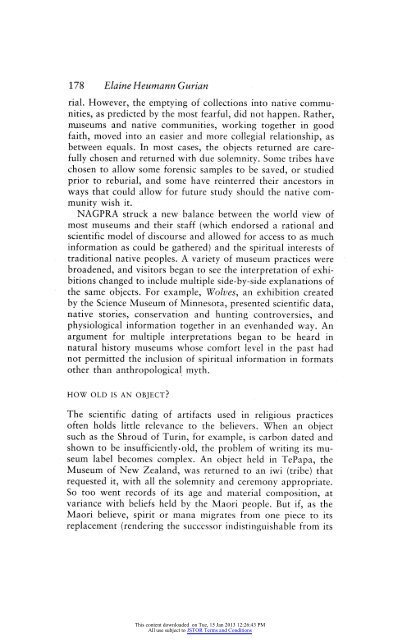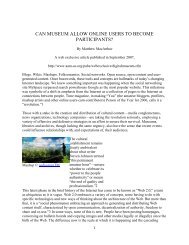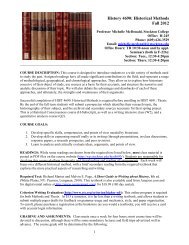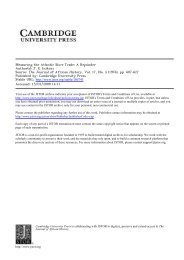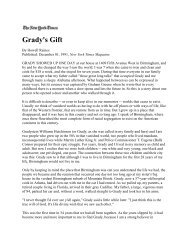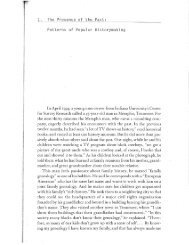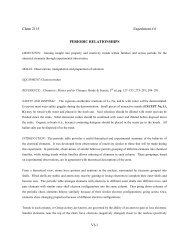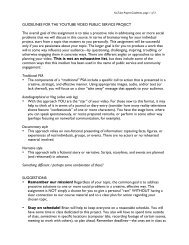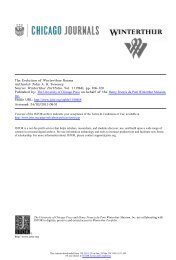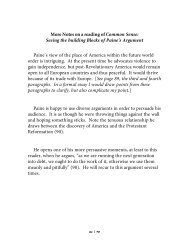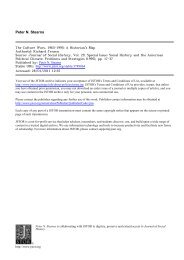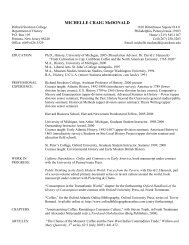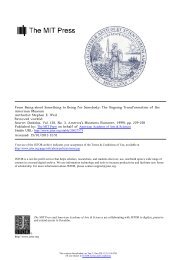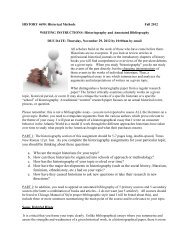What Is the Object of This Exercise? A Meandering Exploration of ...
What Is the Object of This Exercise? A Meandering Exploration of ...
What Is the Object of This Exercise? A Meandering Exploration of ...
You also want an ePaper? Increase the reach of your titles
YUMPU automatically turns print PDFs into web optimized ePapers that Google loves.
178 Elaine Heumann Gurian<br />
rial. However, <strong>the</strong> emptying <strong>of</strong> collections into native commu<br />
nities, as<br />
predicted by <strong>the</strong> most fearful, did not<br />
happen. Ra<strong>the</strong>r,<br />
museums and native communities, working toge<strong>the</strong>r<br />
in<br />
good<br />
faith, moved into an easier and more<br />
coll?gial relationship,<br />
as<br />
between equals. In most cases, <strong>the</strong> objects returned are care<br />
fully chosen and returned with due<br />
solemnity. Some tribes have<br />
chosen to allow some forensic samples<br />
to be saved, or studied<br />
prior<br />
to reburial, and some have reinterred <strong>the</strong>ir ancestors in<br />
ways that could allow for future study should <strong>the</strong> native com<br />
munity wish it.<br />
NAGPRA struck a new balance between <strong>the</strong> world view <strong>of</strong><br />
most museums and <strong>the</strong>ir staff (which endorsed a rational and<br />
scientific model <strong>of</strong> discourse and allowed for access to as much<br />
information as could be ga<strong>the</strong>red) and <strong>the</strong> spiritual interests <strong>of</strong><br />
traditional native<br />
peoples. A variety <strong>of</strong> museum<br />
practices<br />
were<br />
broadened, and visitors began<br />
to see <strong>the</strong> interpretation <strong>of</strong> exhi<br />
bitions changed<br />
to include multiple side-by-side explanations <strong>of</strong><br />
<strong>the</strong> same<br />
objects. For<br />
example, Wolves, an exhibition created<br />
by <strong>the</strong> Science Museum <strong>of</strong> Minnesota, presented scientific data,<br />
native stories, conservation and hunting controversies, and<br />
physiological information toge<strong>the</strong>r in an evenhanded way. An<br />
argument for multiple interpretations began<br />
to be heard in<br />
natural history museums whose comfort level in <strong>the</strong> past had<br />
not permitted <strong>the</strong> inclusion <strong>of</strong> spiritual information in formats<br />
o<strong>the</strong>r than anthropological myth.<br />
HOW OLD IS AN OBJECT?<br />
The scientific dating <strong>of</strong> artifacts used in religious practices<br />
<strong>of</strong>ten holds little relevance to <strong>the</strong> believers. When an object<br />
such as <strong>the</strong> Shroud <strong>of</strong> Turin, for example, is carbon dated and<br />
shown to be<br />
insufficiently? old, <strong>the</strong> problem <strong>of</strong> writing its mu<br />
seum label becomes complex. An object held in<br />
TePapa, <strong>the</strong><br />
Museum <strong>of</strong> New Zealand, was returned to an iwi (tribe) that<br />
requested it, with all <strong>the</strong> solemnity and ceremony appropriate.<br />
So too went records <strong>of</strong> its age and material composition,<br />
at<br />
variance with beliefs held<br />
by <strong>the</strong> Maori<br />
people. But if, as <strong>the</strong><br />
Maori believe, spirit<br />
or mana<br />
migrates from one<br />
piece<br />
to it's<br />
replacement (rendering <strong>the</strong> successor<br />
indistinguishable from its<br />
<strong>This</strong> content downloaded on Tue, 15 Jan 2013 12:26:43 PM<br />
All use subject to JSTOR Terms and Conditions


